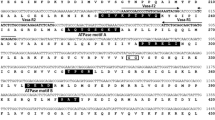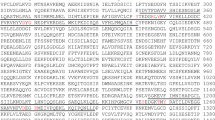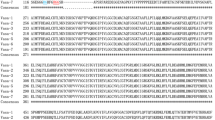Abstract
Identification of molecular markers is an essential step in the study of germ cells. Vasa is an RNA helicase and a well-known germ cell marker that plays a crucial role in germ cell development. Here, we identified the Vasa homolog termed Mpvasa as the first germ cell marker in black carp (Mylopharyngodon piceus). First, a 2819-bp full-length Mpvasa complementary DNA (cDNA) was cloned by PCR using degenerated primers of conserved sequences and gene-specific primers. The Mpvasa cDNA sequence encodes a 637-amino acid protein that contains eight conserved characteristic motifs of the DEAD box protein family, and shares high identity to grass carp (81%) and zebrafish (74%) vasa homologs. Second, Mpvasa expression was restricted to the gonad in adulthood by RT-PCR and Western blot analysis. The dynamic patterns of temporal-spatial expression of Mpvasa during gametogenesis were examined by in situ hybridization, and Mpvasa transcripts were strictly detected in gonadal germ cells throughout oogenesis, predominantly in immature oocytes (stage I, II, and III oocytes). Third, Mpvasa transcripts were highly detected in unfertilized eggs and early embryos, and the signal indicated a dynamic migration of the primordial germ cells during embryogenesis, suggesting that Mpvasa transcripts were maternally inherited and specifically distributed in germ cells. Taken together, these results demonstrated that Mpvasa is an applicable molecular marker for identification of gonadal and embryonic germ cells, which facilitates the isolation and utilization of germ cells in black carp.







Similar content being viewed by others
Abbreviations
- ISH:
-
In situ hybridization
- PGCs:
-
Primordial germ cells
References
Abe K, Noce T (1997) A DEAD-family protein gene, Ddx4, encoding a murine homolog of Drosophila vasa maps to the distal end of mouse chromosome 13. Mamm Genome 8:622–623
Bartholomew RA, Parks JE (2007) Identification, localization, and sequencing of fetal bovine VASA homolog. Anim Reprod Sci 101:241–251
Braat AK, van de Water S, Goos H, Bogerd J, Zivkovic D (2000) Vasa protein expression and localization in the zebrafish. Mech Dev 95:271–274
Braat AK, Zandbergen T, van de Water S, Goos HJ, Zivkovic D (1999) Characterization of zebrafish primordial germ cells: morphology and early distribution of vasa RNA. Dev Dyn 216:153–167
Castrillon DH, Quade BJ, Wang TY, Quigley C, Crum CP (2000) The human VASA gene is specifically expressed in the germ cell lineage. Proc Natl Acad Sci U S A 97:9585–9590
Chapman DC (2006) Early development of four cyprinids native to the Yangtze River, China. USGS Professional Paper 239, 1–51, https://pubs.usgs.gov/ds/2006/239/pdf/ds2006-239.pdf
Eno C, Pelegri F (2013) Gradual recruitment and selective clearing generate germ plasm aggregates in the zebrafish embryo. BioArchitecture 3:125–132
Fujimoto T, Kataoka T, Sakao S, Saito T, Yamaha E, Arai K (2006) Developmental stages and germ cell lineage of the loach (Misgurnus anguillicaudatus). Zool Sci 23:977–989
Fujiwara Y, Komiya T, Kawabata H, Sato M, Fujimoto H, Furusawa M, Noce T (1994) Isolation of a DEAD-family protein gene that encodes a murine homolog of Drosophila vasa and its specific expression in germ cell lineage. Proc Natl Acad Sci U S A 91:12258–12262
Hay B, Jan LY, Jan YN (1988) A protein component of Drosophila polar granules is encoded by vasa and has extensive sequence similarity to ATP-dependent helicases. Cell 55:577–587
Hong Y, Liu T, Zhao H, Xu H, Wang W, Liu R, Chen T, Deng J, Gui J (2004) Establishment of a normal medakafish spermatogonial cell line capable of sperm production in vitro. Proc Natl Acad Sci U S A 101:8011–8016
Huang J, Chen S, Liu Y, Shao C, Lin F, Wang N, Hu Q (2014) Molecular characterization, sexually dimorphic expression, and functional analysis of 3′-untranslated region of vasa gene in half-smooth tongue sole (Cynoglossus semilaevis). Theriogenology 82:213–224
Ikenishi K, Tanaka TS (1997) Involvement of the protein of Xenopus vasa homolog (Xenopus vasa-like gene 1, XVLG1) in the differentiation of primordial germ cells. Develop Growth Differ 39:625–633
Ikenishi K, Tanaka TS (2000) Spatio-temporal expression of Xenopus vasa homolog, XVLG1, in oocytes and embryos: the presence of XVLG1 RNA in somatic cells as well as germline cells. Development Growth and Differentiation 42:95–103
Knaut H, Pelegri F, Bohmann K, Schwarz H, Nuesslein-Volhard C (2000) Zebrafish vasa RNA but not its protein is a component of the germ plasm and segregates asymmetrically before germline specification. J Cell Biol 149:875–888
Knaut H, Steinbeisser H, Schwarz H, Nusslein-Volhard C (2002) An evolutionary conserved region in the vasa 3′ UTR targets RNA translation to the germ cells in the zebrafish. Curr Biol 12:454–466
Kobayashi T, Kajiura-Kobayashi H, Nagahama Y (2000) Differential expression of vasa homologue gene in the germ cells during oogenesis and spermatogenesis in a teleost fish, tilapia, Oreochromis niloticus. Mech Dev 99:139–142
Komiya T, Itoh K, Ikenishi K, Furusawa M (1994) Isolation and characterization of a novel gene of the DEAD box protein family which is specifically expressed in germ cells of Xenopus laevis. Dev Biol 162:354–363
Lasko PF, Ashburner M (1988) The product of the Drosophila gene vasa is very similar to eukaryotic initiation factor-4A. Nature 335:611–617
Lasko PF, Ashburner M (1990) Posterior localization of vasa protein correlates with, but is not sufficient for, pole cell development. Genes Dev 4:905–921
Li C-J, Liu L, Chen X-H, Zhang T, Gan F, Cheng B-L (2010) Identification of a vasa homologue gene in grass carp and its expression pattern in tissues and during embryogenesis. Comparative Biochemistry and Physiology B-Biochemistry & Molecular Biology 157:159–166
Li M, Hong N, Xu H, Yi M, Li C, Gui J, Hong Y (2009) Medaka vasa is required for migration but not survival of primordial germ cells. Mech Dev 126:366–381
Lin F, Liu Q, Li M, Li Z, Hong N, Li J, Hong Y (2012a) Transient and stable GFP expression in germ cells by the vasa regulatory sequences from the red seabream (Pagrus major). Int J Biol Sci 8:882–890
Lin F, Xu S, Ma D, Xiao Z, Zhao C, Xiao Y, Chi L, Liu Q, Li J (2012b) Germ line specific expression of a vasa homologue gene in turbot (Scophthalmus maximus): evidence for vasa localization at cleavage furrows in euteleostei. Mol Reprod Dev 79:803–813
Livak KJ, Schmittgen TD (2001) Analysis of relative gene expression data using real-time quantitative PCR and the 2(−delta delta C(T)) method. Methods 25:402–408
Ma C, Fan L, Ganassin R, Bols N, Collodi P (2001) Production of zebrafish germ-line chimeras from embryo cell cultures. Proc Natl Acad Sci U S A 98:2461–2466
Nakao H, Hatakeyama M, Lee JM, Shimoda M, Kanda T (2006) Expression pattern of Bombyx vasa-like (BmVLG) protein and its implications in germ cell development. Dev Genes Evol 216:94–99
Okutsu T, Yano A, Nagasawa K, Shikina S, Kobayashi T, Takeuchi Y, Yoshizaki G (2006) Manipulation of fish germ cell: visualization, cryopreservation and transplantation. J Reprod Dev 52:685–693
Olsen LC, Aasland R, Fjose A (1997) A vasa-like gene in zebrafish identifies putative primordial germ cells. Mech Dev 66:95–105
Otani S, Maegawa S, Inoue K, Arai K, Yamaha E (2002) The germ cell lineage identified by vas-mRNA during the embryogenesis in goldfish. Zool Sci 19:519–526
Pacchiarini T, Cross I, Leite RB, Gavaia P, Ortiz-Delgado JB, Pousao-Ferreira P, Rebordinos L, Sarasquete C, Cabrita E (2013) Solea senegalensis vasa transcripts: molecular characterisation, tissue distribution and developmental expression profiles. Reproduction Fertility and Development 25:646–660
Raz E (2000) The function and regulation of vasa-like genes in germ-cell development. Genome Biol 1:1–6
Raz E (2002) Primordial germ cell development in zebrafish. Semin Cell Dev Biol 13:489–495
Saito T, Fujimoto T, Maegawa S, Inoue K, Tanaka M, Arai K, Yamaha E (2006) Visualization of primordial germ cells in vivo using GFP-nos1 3′UTR mRNA. Int J Dev Biol 50:691–699
Saotome K, Hayashi K, Adachi N, Nakamura Y, Nakamura M (2010) Isolation and characterization of vasa in the frog Rana rugosa. J Exp Zool A Ecol Genet Physiol 313:452–459
Selman K, Wallace RA, Sarka A, Qi X-P (1993) Stages of oocyte developmentin the zebrafish, Brachydanio rerio. J Morphol 218:203–224
Sengoku T, Nureki O, Nakamura A, Satoru KI, Yokoyama S (2006) Structural basis for RNA unwinding by the DEAD-box protein Drosophila vasa. Cell 125:287–300
Shinomiya A, Tanaka M, Kobayashi T, Nagahama Y, Hamaguchi S (2000) The vasa-like gene, olvas, identifies the migration path of primordial germ cells during embryonic body formation stage in the medaka, Oryzias latipes. Develop Growth Differ 42:317–326
Shirae-Kurabayashi M, Nishikata T, Takamura K, Tanaka KJ, Nakamoto C, Nakamura A (2006) Dynamic redistribution of vasa homolog and exclusion of somatic cell determinants during germ cell specification in Ciona intestinalis. Development 133:2683–2693
Sugimoto K, Koh E, Sin HS, Maeda Y, Narimoto K, Izumi K, Kobori Y, Kitamura E, Nagase H, Yoshida A, Namiki M (2009) Tissue-specific differentially methylated regions of the human VASA gene are potentially associated with maturation arrest phenotype in the testis. J Hum Genet 54:450–456
Sun A, Chen SL, Gao FT, Li HL, Liu XF, Wang N, Sha ZX (2015) Establishment and characterization of a gonad cell line from half-smooth tongue sole Cynoglossus semilaevis pseudomale. Fish Physiol Biochem 41:673–683
Takeuchi Y, Yoshizaki G, Kobayashi T, Takeuchi T (2002) Mass isolation of primordial germ cells from transgenic rainbow trout carrying the green fluorescent protein gene driven by the vasa gene promoter. Biol Reprod 67:1087–1092
Tanaka M, Kinoshita M, Kobayashi D, Nagahama Y (2001) Establishment of medaka (Oryzias latipes) transgenic lines with the expression of green fluorescent protein fluorescence exclusively in germ cells: a useful model to monitor germ cells in a live vertebrate. Proc Natl Acad Sci U S A 98:2544–2549
Tanaka SS, Toyooka Y, Akasu R, Katoh-Fukui Y, Nakahara Y, Suzuki R, Yokoyama M, Noce T (2000) The mouse homolog of Drosophila vasa is required for the development of male germ cells. Genes Dev 14:841–853
Tsunekawa N, Naito M, Sakai Y, Nishida T, Noce T (2000) Isolation of chicken vasa homolog gene and tracing the origin of primordial germ cells. Development 127:2741–2750
Wang C, Wang J, Yang J, Lu G, Song X, Chen Q, Xu J, Yang Q, Li S (2012) Complete mitogenome sequence of black carp (Mylopharyngodon piceus) and its use for molecular phylogeny of leuciscine fishes. Mol Biol Rep 39:6337–6342
Wolke U, Weidinger G, Koprunner M, Raz E (2002) Multiple levels of posttranscriptional control lead to germ line-specific gene expression in the zebrafish. Curr Biol 12:289–294
Wylie C (1999) Germ cells. Cell 96:165–174
Xu H, Gui J, Hong Y (2005) Differential expression of vasa RNA and protein during spermatogenesis and oogenesis in the gibel carp (Carassius auratus gibelio), a bisexually and gynogenetically reproducing vertebrate. Dev Dyn 233:872–882
Xu H, Li M, Gui J, Hong Y (2010) Fish germ cells. Sci China Life Sci 53:435–446
Xu H, Li Z, Li M, Wang L, Hong Y (2009) Boule is present in fish and bisexually expressed in adult and embryonic germ cells of medaka. PLoS One 4:e6097
Xu H, Lim M, Dwarakanath M, Hong Y (2014) Vasa identifies germ cells and critical stages of oogenesis in the Asian seabass. Int J Biol Sci 10:225–235
Yamaha E, Saito T, Goto-Kazeto R, Arai K (2007) Developmental biotechnology for aquaculture, with special reference to surrogate production in teleost fishes. J Sea Res 58:8–22
Yoon C, Kawakami K, Hopkins N (1997) Zebrafish vasa homologue RNA is localized to the cleavage planes of 2- and 4-cell-stage embryos and is expressed in the primordial germ cells. Development 124:3157–3165
Yoshizaki G, Sakatani S, Tominaga H, Takeuchi T (2000a) Cloning and characterization of a vasa-like gene in rainbow trout and its expression in the germ cell lineage. Mol Reprod Dev 55:364–371
Yoshizaki G, Tago Y, Takeuchi Y, Sawatari E, Kobayashi T, Takeuchi T (2005) Green fluorescent protein labeling of primordial germ cells using a nontransgenic method and its application for germ cell transplantation in Salmonidae. Biol Reprod 73:88–93
Yoshizaki G, Takeuchi Y, Sakatani S, Takeuchi T (2000b) Germ cell-specific expression of green fluorescent protein in transgenic rainbow trout under control of the rainbow trout vasa-like gene promoter. Int J Dev Biol 44:323–326
Acknowledgments
This work was supported by grants from the National Key Basic Research Program of China (2013CB967700 to TC) and Huazhong Agricultural University Scientific and Technological Self-innovation Foundation (2013RC014; 2662015PY049). This work contains part of the Ph.D. thesis of XT.
Contribution statement
XT contributed to the study design and the acquisition, analysis, and interpretation of the data. YM, FJ, DY, CK, PQ, LL, WY, and WQ contributed to the analysis and interpretation of data. CT contributed to the conception and design of the research, the analysis and interpretation of the data, and drafting/revising the article. All authors approved the final version to be published. CT is responsible for the integrity of the work as a whole.
Author information
Authors and Affiliations
Corresponding author
Ethics declarations
Conflict of interest
The authors declare that they have no competing interests.
Additional information
Communicated by Matthias Hammerschmidt
Electronic supplementary material
Fig. S1
Detection by Mpvasa sense probe or pre-immune serum in the adult ovary. A. The negative fluorescent signal detected by Mpvasa sense probe. B. Merged micrographs of PI staining and Mpvasa sense staining. C. The negative fluorescent signal detected by pre-immune serum. D. Merged micrographs of PI staining and pre-immune serum staining. CA, Cortical alveoli; ZR, Zona Radiata; FE, Follicular Epithelium; YG, Yolk Granule. Scale bars: 100 μm. (PPTX 363 kb)
Fig. S2
The whole mount in situ hybridization in developing embryos by Mpvasa sense probe. Whole embryos at various stages were subjected to ISH with sense Mpvasa probe and observed under microscopy. A: 2-cell stage. B: blastula stage. C: neurula stage. D: tail bud stage. E: heart pulsation stage. Scale bars, 200 μm. (PPTX 1235 kb)
Rights and permissions
About this article
Cite this article
Xue, T., Yu, M., Pan, Q. et al. Black carp vasa identifies embryonic and gonadal germ cells. Dev Genes Evol 227, 231–243 (2017). https://doi.org/10.1007/s00427-017-0583-6
Received:
Accepted:
Published:
Issue Date:
DOI: https://doi.org/10.1007/s00427-017-0583-6




